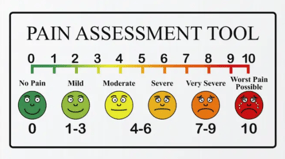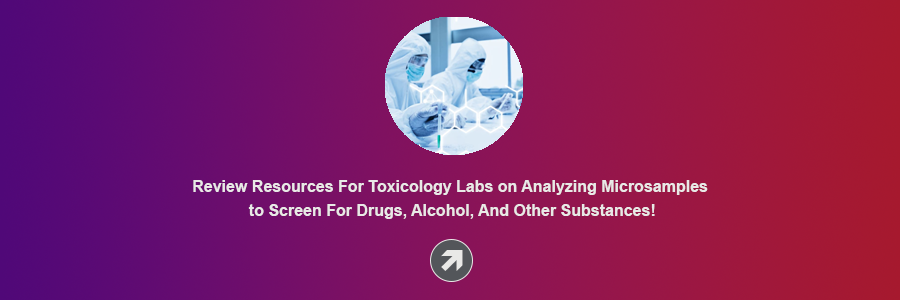Share this
drug adherence monitoring in leukemia using microsampling
by James Rudge, PhD, Technical Director, Trajan on Feb 13, 2023 9:00:00 AM
An article by Marina V. Antunes et al at several institutions in Brazil published in the January 2023 edition of the Journal of Pharmaceutical and Biochemical Analysis, validated an assay measuring imatinib mesylate and its main metabolite from finger-stick blood microsamples for therapeutic drug monitoring (TDM). The paper is entitled “Volumetric dried blood microsampling for monitoring imatinib mesylate therapy: Method development and clinical application in patients with chronic myeloid leukemia.”
 The study provided volunteers with Mitra® microsampling devices based on VAMS® technology for self-collection of blood samples. The portable microsampling devices showed high volunteer acceptance of capillary sampling with very low pain scores.
The study provided volunteers with Mitra® microsampling devices based on VAMS® technology for self-collection of blood samples. The portable microsampling devices showed high volunteer acceptance of capillary sampling with very low pain scores.
Chronic Myeloid Leukemia and Imatinib
Chronic myeloid leukemia (CML) is a blood cancer of hematopoietic stem cells leading to increased myeloid hyperplasia of the bone marrow. Detection of the Philadelphia (Ph+) chromosome, a genetic abnormality of chromosome 22 through the formation of a fusion gene called BCR-ABL, is used to confirm diagnosis.
Imatinib mesylate (IM) is a tyrosine kinase inhibiter (TKI) drug used as a first line treatment of chronic myeloid leukemia in patients who have the Ph+ chromosome. Imatinib was invented by biochemist Micholas Lyndon working at Ciba-Geigy (now Novartis), and the drug was approved by the US Food and Drug Administration (FDA) in May 2001. Imatinib acts to inhibit several tyrosine kinases (TK), including the TK produced from the BCR-ABL fusion gene, which acts to switch off signaling pathways that promote leukemogenesis.
IM is mainly metabolized by the cytochrome P450 system, and the primary metabolite is a N-demethylated (NIM) derivative which has similar pharmacological activity as the parent drug. According to previous studies quoted in the paper, IM has a narrow therapeutic window where plasma concentrations above 1000 ng/ml1 have a higher probability of both therapeutic and molecular responses.
In fact, the paper quoted one previous study in which increasing the intake of IM from 90 to 100%, was found to increase treatment response likelihood by up to 2-fold. Conversely, plasma concentrations above 3000 ng/ml-1 have been linked to adverse side effects from IM, such as neutropenia and edema.
The Need for Therapeutic Drug (TDM) Monitoring of IM
 Due to imatinib mesylate’s narrow therapeutic window, adherence needs to be carefully measured for both dose optimization and adherence. The researchers highlighted that therapeutic drug monitoring (TDM) was important for adherence, drug optimization and possible drug interaction. They also highlighted the challenges in implementing TDM of IM, primarily due to the need for specialized laboratories for measuring the TKI. Indeed, they pointed out that this can be a logistical challenge for countries such as Brazil, where long distances can be a challenge if transporting liquid blood samples.
Due to imatinib mesylate’s narrow therapeutic window, adherence needs to be carefully measured for both dose optimization and adherence. The researchers highlighted that therapeutic drug monitoring (TDM) was important for adherence, drug optimization and possible drug interaction. They also highlighted the challenges in implementing TDM of IM, primarily due to the need for specialized laboratories for measuring the TKI. Indeed, they pointed out that this can be a logistical challenge for countries such as Brazil, where long distances can be a challenge if transporting liquid blood samples.
The study authors underlined the benefits of remote, home collection of dried capillary samples, as a more comfortable and convenient approach for patients. This sampling approach is also easier for study coordinators, because dried blood samples can be shipped via standard mail to a central lab without cold shipping or complicated logistics – just a standard shipping envelope and postage.
Remote TDM May Be Optimal for Effective Imatinib Measurement
In terms of pharmacokinetic measurement, home collection approaches (using Mitra devices with VAMS, for example), allow more flexibility for samples to be collected at different time points. This flexibility inspired the research group to develop a VAMS assay to measure both IM and its main metabolite as a possible tool for remote collection of IM samples.
One reason for choosing VAMS was that a successful assay to measure IM had been previously developed as part of a panel of 8 TKIs. To further advance the work that had already been reported, the group embarked on developing a method to measure both the main metabolite (NIM) and parent drug (IM) from CML patients. An important outcome of the new study was to understand the impact of remote, at-home sampling on patient satisfaction and treatment adherence.
Drug Adherence Study Methods and Findings
- Validated an LC-MS/MS assay in accordance with European Medicines Agency, US Food & Drug Administration, and International Association of Therapeutic Drug Monitoring and Clinical Toxicology guidelines.
- The researchers noted a number of key highlights pertaining to remote Mitra devices with VAMS technology, included below.
- Extraction of IM and NIM from VAMS devices was conducted using a protein precipitation approach involving 0.1 %formic acid in water, acetonitrile, and cooling to – 20 °C.
- Storing VAMS microsamples at both room temperature and 45 °C (to mimic tropical conditions) over 3, 6, 14 and 21 days was evaluated. Both NIM and IM were found to be stable for up to two weeks, even at the higher temperature. The group noted that the samples could be transported for up to two weeks without cryostorage.
- When looking at a range of hematocrit levels (HCT = 25-55%) a mean extraction yield of 93% for IM and 91% for NIM was observed with a only 10% bias. Similarly, the impact of accuracy was not adversely effected by the HCT range tested. This had been observed in the previous study the authors cited in their paper.
Clinical Processes:
- Patients with CML (n=33) were recruited and trained on collecting finger-stick blood microsamples using Mitra devices with VAMS technology, before returning home with kits for self-sampling.
- According to answers provided on a Morisky-Green questionnaire, 65.6% of patients had high adherence, 18.8% had moderate adherence, and 15.6 reported low levels of adherence.
- Using a blood to plasma ratio of 1.28 as a multiplier the group was able to obtain an estimated plasma concentration. Interestingly, the concentrations of IM in the adherent and non-adherent groups were not statistically different.
- However, the researchers reported, “Adherent patients had higher [IM]/dose ratios (P = 0.05), with a median (P25-P75) of 2.38 (1.68–3.41) when compared to individuals with some level of non-adherence, which presented a median of 1.54 (0.91–2.86)."
Feedback provided by study volunteers via the questionnaire showed some promising results:
- 91% would be able to perform home testing if available.
- 18 showed preference for self-collection, 10 for collection in clinic, and 5 had no preference.
- Compared to venipuncture, 87% felt less discomfort using VAMS.
 According to a standard table of pain scores (0-10, where 0 = no pain and 10 = the worst pain possible) when using Mitra devices with VAMS to collect finger-stick blood samples, the following was recorded:
According to a standard table of pain scores (0-10, where 0 = no pain and 10 = the worst pain possible) when using Mitra devices with VAMS to collect finger-stick blood samples, the following was recorded: - 45.2% reported no pain.
- 16.2 reported little pain.
- 38.7 reported mild pain between scores 1 and 2.
- 97% felt they were able to perform self-collection.
- 31 out of 33 study volunteers successfully collected at least 1 sample with an appropriate volume of blood and 23 collected all 3 samples correctly.
Drug Adherence Study Author’s Conclusions
- The research group developed a LC-MS/MS assay sufficient to measure IM and NIM.
- The research group concluded that the main advantages of using VAMS included a minimally invasive collection procedure, allowing for at home collection, the stability of the analyte, and reduced storage and transportation costs.
Neoteryx Comments
This paper demonstrates the importance of developing high-quality TDM assays for potential deployment across broad geographical areas, where the sheer size of the country makes transportation of traditionally collected wet samples challenging and costly.
The results of the study volunteer questionnaire demonstrated that 87% felt less discomfort using Mitra devices with VAMS compared to venipuncture. All reported either no pain or little pain on the pain score related to lancing their fingers to collect the blood samples. This study’s findings may negate the need to resort to other more costly blood sampling solutions available.
This article was summarized for our readers by James Rudge, PhD, Technical Director. This is curated content. To learn more about the important research outlined in this blog, visit the original article in the Journal of Pharmaceutical and Biochemical Analysis.
Image Credits: iStock, Neoteryx, Trajan

Share this
- Microsampling (206)
- Research, Remote Research (119)
- Venipuncture Alternative (106)
- Clinical Trials, Clinical Research (83)
- Mitra® Device (73)
- Therapeutic Drug Monitoring, TDM (51)
- Dried Blood Spot, DBS (39)
- Biomonitoring, Health, Wellness (30)
- Infectious Disease, Vaccines, COVID-19 (24)
- Blood Microsampling, Serology (23)
- Omics, Multi-Omics (21)
- Decentralized Clinical Trial (DCT) (20)
- Specimen Collection (18)
- Toxicology, Doping, Drug/Alcohol Monitoring, PEth (17)
- Skin Microsampling, Microbiopsy (14)
- hemaPEN® Device (13)
- Preclinical Research, Animal Studies (12)
- Pharmaceuticals, Drug Development (9)
- Harpera Device (7)
- Industry News, Microsampling News (5)
- Antibodies, MAbs (3)
- Company Press Release, Product Press Release (3)
- Environmental Toxins, Exposures (1)
- July 2025 (1)
- May 2025 (1)
- April 2025 (2)
- December 2024 (2)
- November 2024 (1)
- October 2024 (3)
- September 2024 (1)
- June 2024 (1)
- May 2024 (1)
- April 2024 (4)
- March 2024 (1)
- February 2024 (2)
- January 2024 (4)
- December 2023 (3)
- November 2023 (3)
- October 2023 (3)
- September 2023 (3)
- July 2023 (3)
- June 2023 (2)
- April 2023 (2)
- March 2023 (2)
- February 2023 (2)
- January 2023 (3)
- December 2022 (2)
- November 2022 (3)
- October 2022 (4)
- September 2022 (3)
- August 2022 (5)
- July 2022 (2)
- June 2022 (2)
- May 2022 (4)
- April 2022 (3)
- March 2022 (3)
- February 2022 (4)
- January 2022 (5)
- December 2021 (3)
- November 2021 (5)
- October 2021 (3)
- September 2021 (3)
- August 2021 (4)
- July 2021 (4)
- June 2021 (4)
- May 2021 (4)
- April 2021 (3)
- March 2021 (5)
- February 2021 (4)
- January 2021 (4)
- December 2020 (3)
- November 2020 (5)
- October 2020 (4)
- September 2020 (3)
- August 2020 (3)
- July 2020 (6)
- June 2020 (4)
- May 2020 (4)
- April 2020 (3)
- March 2020 (6)
- February 2020 (3)
- January 2020 (4)
- December 2019 (5)
- November 2019 (4)
- October 2019 (2)
- September 2019 (4)
- August 2019 (4)
- July 2019 (3)
- June 2019 (7)
- May 2019 (6)
- April 2019 (5)
- March 2019 (6)
- February 2019 (5)
- January 2019 (8)
- December 2018 (3)
- November 2018 (4)
- October 2018 (7)
- September 2018 (6)
- August 2018 (5)
- July 2018 (8)
- June 2018 (6)
- May 2018 (5)
- April 2018 (6)
- March 2018 (4)
- February 2018 (6)
- January 2018 (4)
- December 2017 (2)
- November 2017 (3)
- October 2017 (2)
- September 2017 (4)
- August 2017 (2)
- July 2017 (4)
- June 2017 (5)
- May 2017 (6)
- April 2017 (6)
- March 2017 (5)
- February 2017 (4)
- January 2017 (1)
- July 2016 (3)
- May 2016 (1)
- April 2016 (2)


No Comments Yet
Let us know what you think